1st November 2022
I got to the uni early and went into the Basement Studio area and had a chat with a couple of classmates before picking up the Contact Printer, Focus Finder and Multigrade Filters from the Media Stores/Dan I was going to use in the darkroom later.
Show & Tell
We all gathered around and Niki said that she wanted us to share our progress on the independent project so far so some of us who had physical or digital material waited whilst we discussed the ideas of the few who hadn’t got anything to show but were thinking it through.
There were some interesting discussions about what each of my comrades in arts was planning on doing, with some being a bit shy and having really nice information teased out of them. Some were not going to show their work as they thought it to be not good enough but the work produced was really insightful and thought provoking.
One person mentioned using bottles to represent how emotions are bottled up and having images inside them to represent people and how they think and feel. I felt it might be a good way of symbolising alcoholism if I decide to do work revolving around my dad at some point.
Another student suggested that he might make pictures of nature in brutalist architecture areas and City Arcade on Union Street in Birmingham might be worth a visit after it was recently bought with an eye to doing it up.
Paul from L5 suggested that he look at, and I noted it down for my own work, the Birmingham Brutalist Climbing Walls, actually some brutalist murals, The William Mitchell murals at Hockley Flyover, Birmingham are interesting to look at and something that I must take a gander at sometime in the near future. More information is available on the C20 website who are similar to the Modernist magazine and society.
A couple of the long exposure image ideas really piqued my interest and I found them fascinating.
Niki mentioned an artist who had been the resident artist at HMP Grendon before Dean Kelland, called Edmund Clark he worked with the prisoners to make art and as Niki told us you are not allowed to take identifiable photos of inmates so Clark had a pinhole camera set up so that he could record an image of an inmate talking that would not produce a recognisable facial image.
Some of Clark’s work can be seen here on the FT website.
She also followed it up with mention of Idris Khan, an artist who has produced long exposure with intentional camera movement images of some london landmarks. A website featuring a bio on Khan can be seen here
One that I’d heard of before Alexey Titarenko also does long exposure images and his work “City Of Shadows“ has some outstanding images of people moving through scenes with varying clarity of people.
One of my fellow students talked about his work and of water when he showed us some images of Lake Vyrnwy before Niki informed us that Water is a motif in images to symbolise Chance.
I suggested that water can be in different forms too, like Ice and Steam.
Bob’s Chop Shop
When it came to my turn I showed off the tests that I’d done the week before consisting of the following work.
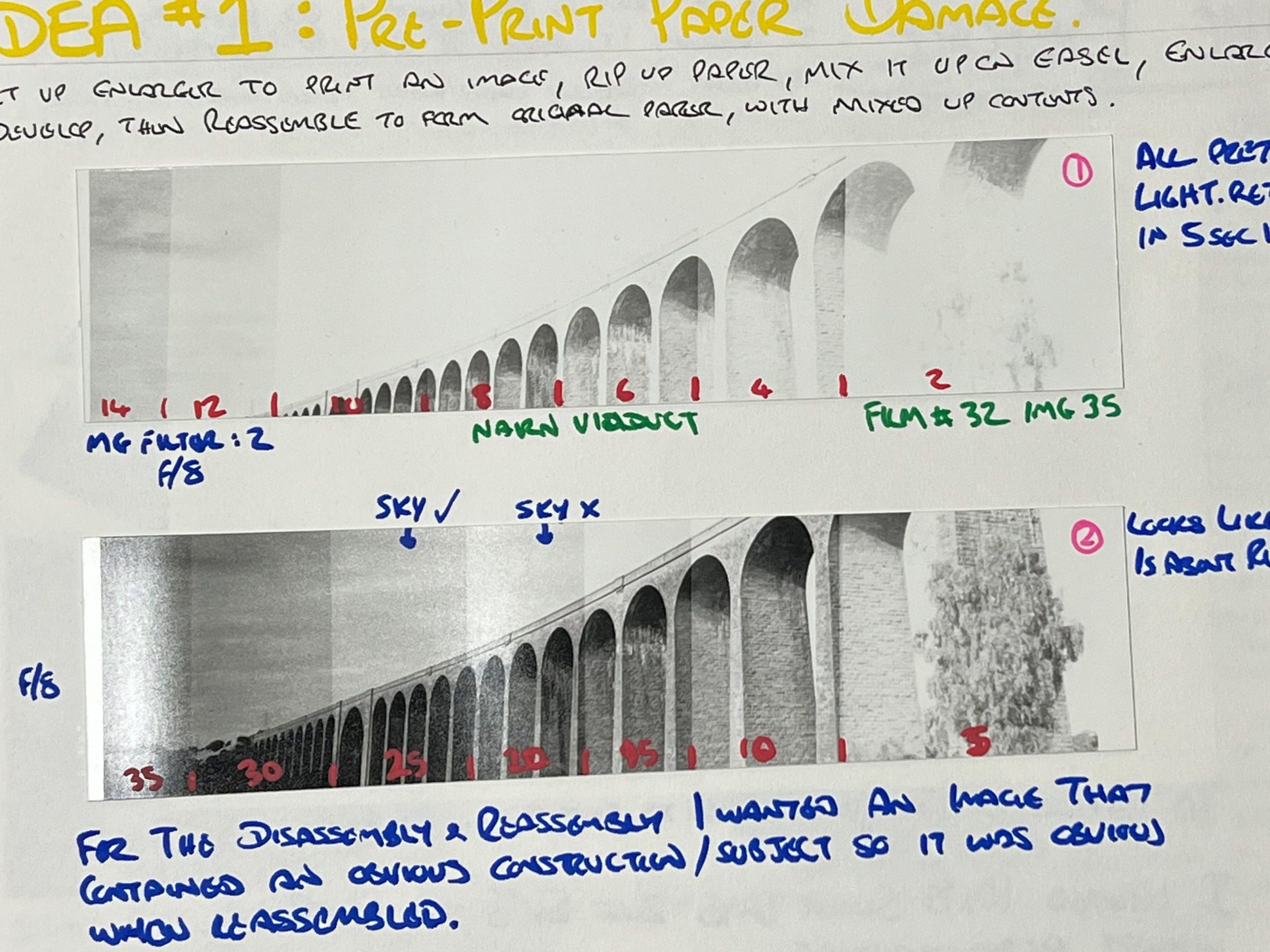
This first couple of test strips was setting me up to use the enlarger for the rest of the experiments I was going to perform on paper in the easel.

You can see from the image before that I selected a print with a good bit of structure and pattern in it so that it might prove to be an interesting image when mixed up. It’s also printed on 8×5 paper as I could get two prints out of a sheet of 10×8 whilst I’m experimenting.
The first effort of chopping up a piece of paper was a random lot of cuts with scissors but before I cut it up I marked the rear of the image with multiple lines so that I knew how to reassemble after the process was completed.

I cut the paper up randomly and then mixed them all up on the easel under the negative of the viaduct, hit it with a 25 second exposure on f/8 with a number 2 Multigrade filter. There were some parts of the arrangement that overlapped and some that sat under the easel masking bars.
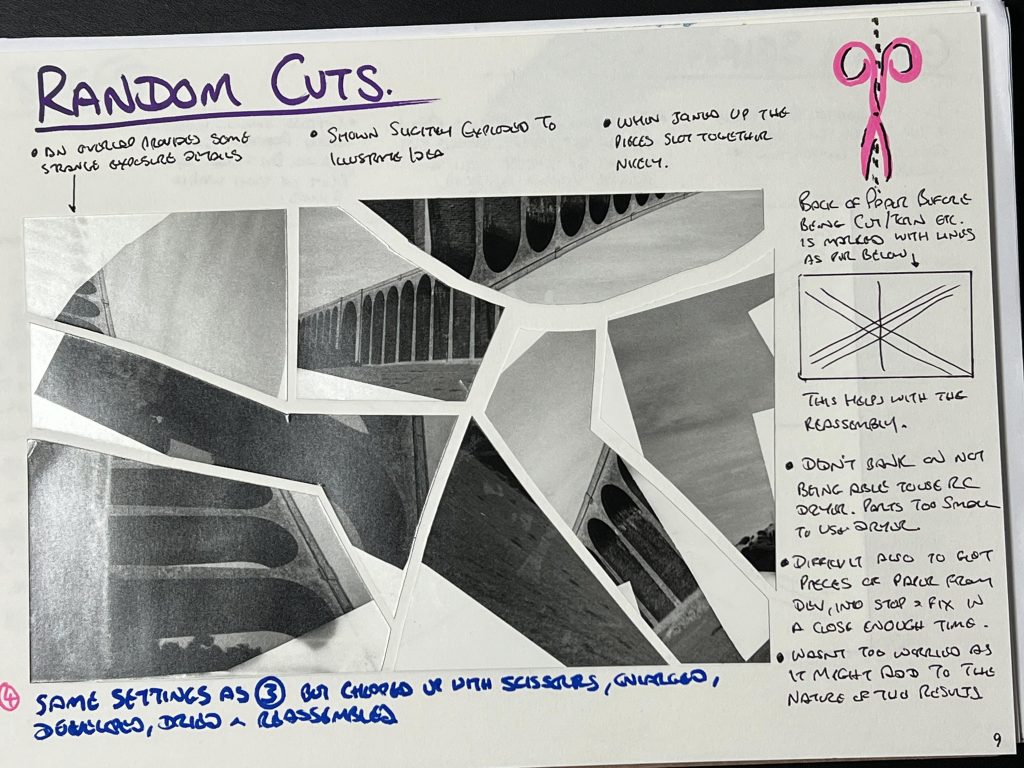
Once I’d exposed and then popped the pieces in the Developer dish for a minute, Stop bath for 15 secs and a fixer dish for another minute before two minutes in the water wash. It was as I dropped the pieces into the Dev dish that I realised that I wouldn’t be able to dry the pieces in the RC Dryer so needed to leave them hanging on the drying line above the tanks. It was also tricky trying to fish the pieces of paper from dev, to stop,to fix and wash all at a similar time as all of the others.
The next trial was based on the Golden Spiral, based upon Fibonacci’s work, which is used in composition of photography and art. It involves cutting the paper into two pieces, one 1.618 times the width of the other, then the smaller piece is then cut in the same ratio. I only got so far with this as I wasn’t sure if it would work, but I might try it again with a smaller cut. There was too much white space in the image for me but I quite liked the couple of parts that were overlapped. I might try some more of this.
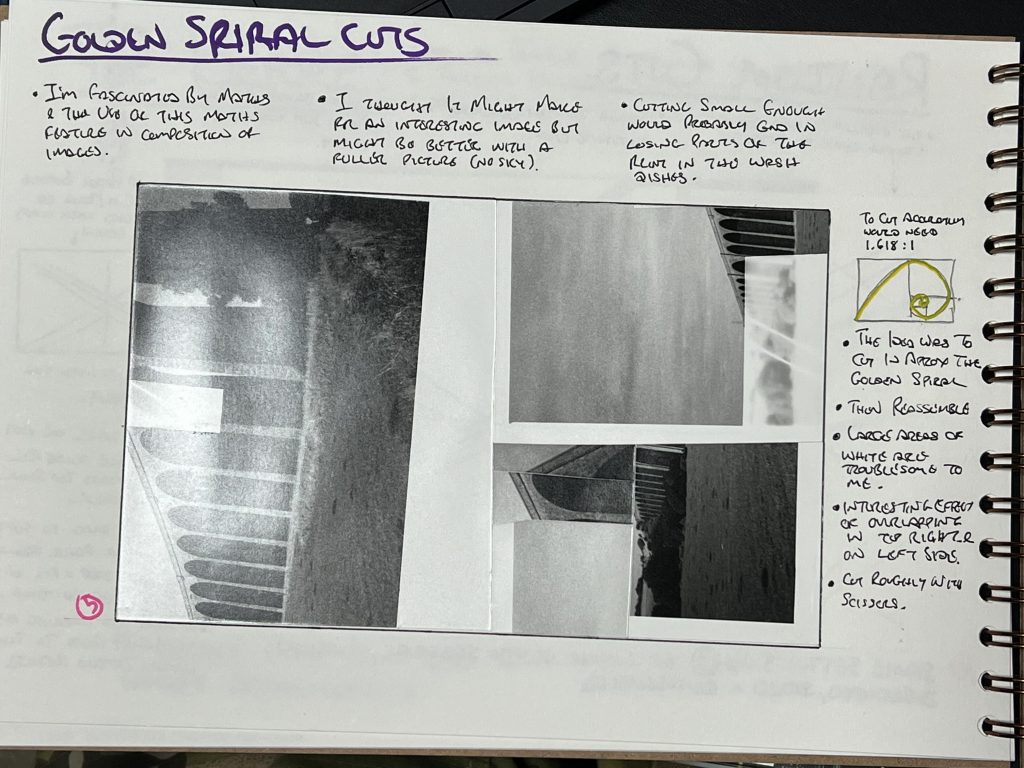
The next image was more simple to cut and reassemble but I felt it lacked some randomness. I quite like the effect of parts being flipped over and spun around. As we were looking at this image, Niki suggested that I might try weaving images together and linking this with the overlapping idea from the previous I wonder about weaving a sliced image into a blank sheet and then exposing it so some of the print is normal and some is a result of an overlapped section.
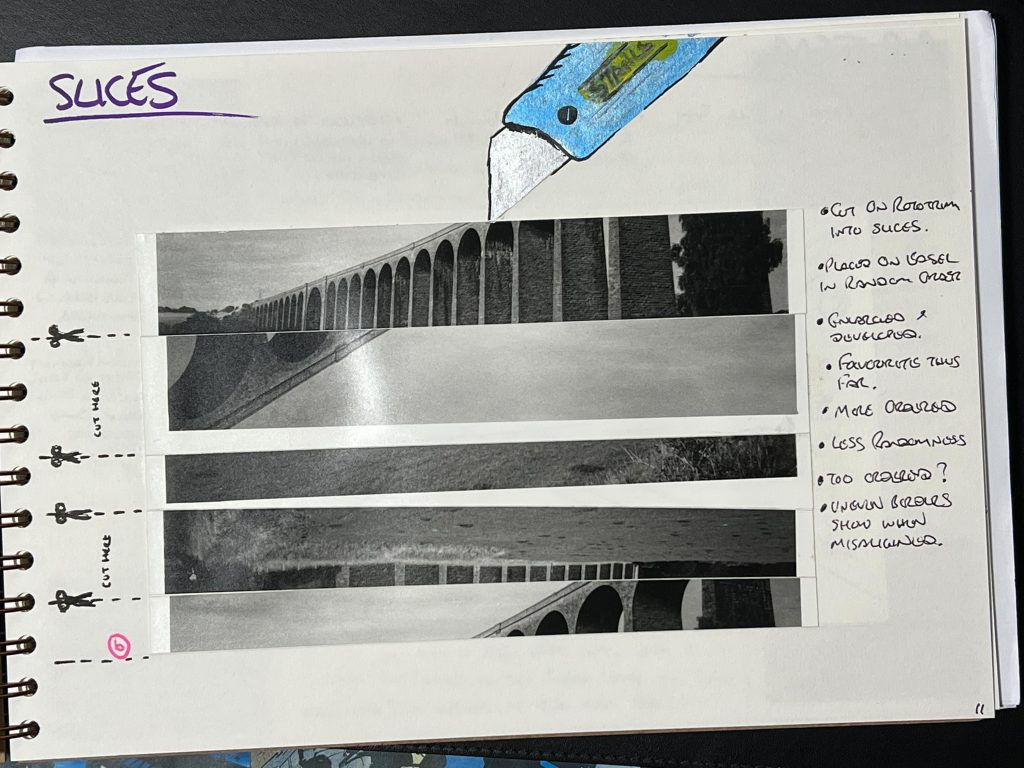
The last image I played with was torn up paper and then mixing it up on the easel, printing to it and then reassembling in the correct orientation. I quite like the torn edges aesthetic but I’m not 100% sure that the overall look is one that is as nice as some of the others. Again there are some masked of areas where some parts are lighter than others. I’m liking the overlapped parts the more I see it…
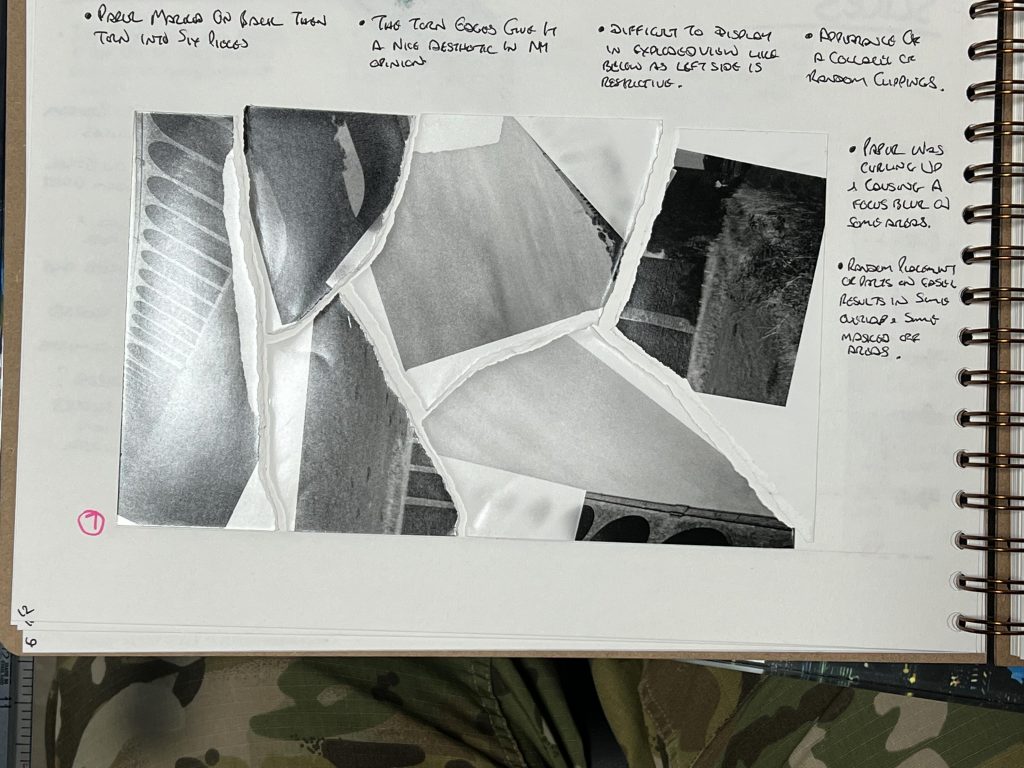
Once I’d finished playing with the above image, I wanted to try a print with less negative space/sky and chose an image of flowers on the fence at Buckingham Palace the day after the Queen died in early September. I thought that it was a more packed image with lots of similar imagery, some fencing and some people too. It felt like a jigsaw when I examined the print and that’s when I chose to research a bit of info on jigsaws. See further down..

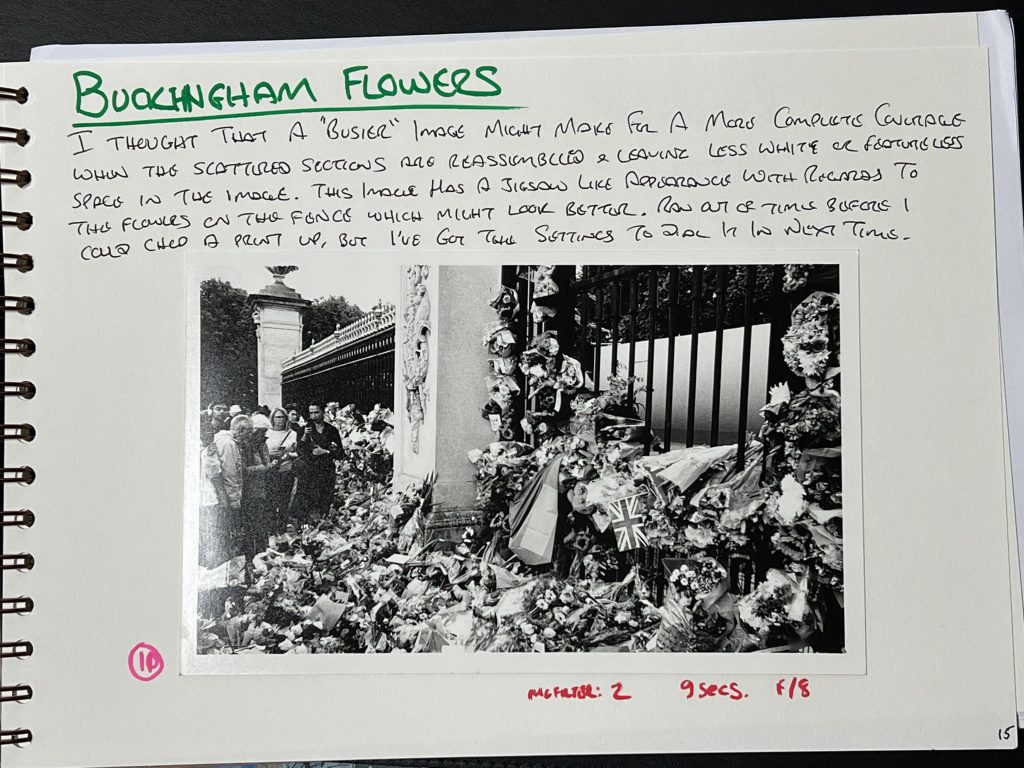
I got the test strips done and a print completed but then ran out of time so thought I’d revisit this image next time I’m there.
Reasoning?
Once I’d explained what I was doing, I thought I’d ask why I was doing this? I’m not 100% sure how I got to this route of messing with photos and disrupting them in different ways. One of my friends suggested that I’d used the word Structure intentionally when I selected a picture of a viaduct and perhaps I was trying to break down structures int osmaller parts. I’m not sure if this is something I feel myself or is it a subconscious thing? It could also be that I deal in digital domain all day in my full time job so I’m looking at using my hands and physical media. It could be said when I print on shuffled parts and then reassemble it could truly be called “Mixed Media”
With weaving images together Niki suggested looking at work by Hannah Höch who is well known for her photomontages and collages.
Since I’d been playing with the prints as per the above section I’d been having ideas around jigsaws and found the artist Tim Klein who mixes up jigsaw puzzles that have been cut with the same die cut tool. I was reminded of an episode of Dave Gorman’s Modern Life is Goodish where he found the same fact about different jigsaws and made his mum a funny mixture of Tom Jones and Alan Sugar puzzles.
I wondered If I could make a print in a mixed up order on jigsaw pieces so that when I installed it on jigsaw pieces it would all fit together correctly but the picture would be completely messed up.
The next time I was to go to the darkroom I was taking with me a laser pointer and also a small pen torch with a homemade cone snoot to narrow the beam. This was going to be used to paint light onto the image after it was under the enlarger.
Hopefully I’ll get a chance to that on Friday !!
[…] Once happy with this coming out of the RC Dryer I loaded up the contact printer with the negs from film #32 containing images of the trip around the NC500 in Scotland. Some of which show the Nairn Viaduct from a previous post. […]
[…] I’ve been experimenting with breaking up images and reconstructing them. In some of my earlier works I chopped or ripped up and then scrambled the photo paper before I enlarged an image from a […]